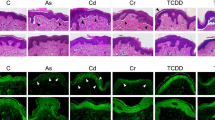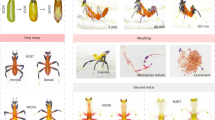The red and orange pigments in this secretion account for its protective properties.
Abstract

Within a few minutes of perspiration, the colourless, viscous sweat of the hippopotamus gradually turns red, and then brown as the pigment polymerizes. Here we isolate and characterize the pigments responsible for this colour reaction. The unstable red and orange pigments turn out to be non-benzenoid aromatic compounds that are unexpectedly acidic and have antibiotic as well as sunscreen activity.
This is a preview of subscription content, access via your institution
Access options
Subscribe to this journal
Receive 51 print issues and online access
$199.00 per year
only $3.90 per issue
Buy this article
- Purchase on SpringerLink
- Instant access to full article PDF
Prices may be subject to local taxes which are calculated during checkout

Similar content being viewed by others
References
Eltringham, S. K. The Hippos 8–38 (Poyser Natural History Series, London, 1999).
Author information
Authors and Affiliations
Corresponding author
Ethics declarations
Competing interests
The authors declare no competing financial interests.
Supplementary information
Supplementary Figure 1
UV-VIS spectrum of hipposudoric acid (JPG 23 kb)
Supplementary Figure 2
UV-VIS spectrum of norhipposudoric acid (JPG 24 kb)
Rights and permissions
About this article
Cite this article
Saikawa, Y., Hashimoto, K., Nakata, M. et al. The red sweat of the hippopotamus. Nature 429, 363 (2004). https://doi.org/10.1038/429363a
Issue date:
DOI: https://doi.org/10.1038/429363a
This article is cited by
-
A molecular spectroscopy approach for the investigation of early phase ochronotic pigment development in Alkaptonuria
Scientific Reports (2021)
-
Mosquito repellence induced by tarsal contact with hydrophobic liquids
Scientific Reports (2020)
-
Hippos beat the burn
Nature (2004)



